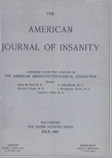Abstract
1. Of 1,932 mental patients who formed the male population of Eloise Hospital on February 15, 1940, 130 or 6.7 per cent were found to be sex delinquents.
2. Fourteen or 10.8 per cent of the group of 130 patients were actual sex offenders before the recognizable onset of their psychosis.
3. One hundred and sixteen, or 89.2 per cent, gave a history of sexual deviation after the recognized onset of their psychosis. Some of the credit for this preponderance could be accorded to the fact that mental hospitals would contain more patients showing psychotic symptomatology than those whose lack of such manifestations would lead to prison sentences rather than commitment to a mental institution.
4. In an age range from 7 to 94 years at the time of admission to the hospital, the majority of patients came from the third and fourth decades, with the peak being reached in the fourth and fifth decade, which is in keeping with the general male admission rate.
5. Sixty-seven per cent of the offenders were single, 15 per cent married and the remainder were divorced or widowers at the time of hospitalization.
6. 38.5 per cent of the patients came from intact homes. However, the combination of intact, but unstable homes, disrupted homes, and those cases where the home status was unknown, suggested that the majority of the patients had poor home environment.
7. There were 44.6 per cent untainted patients as compared with 54.4 per cent who gave evidence of tainting, which seemed to indicate that tainting had little bearing upon the incidence of sex delinquency.
8. The percentage of the type of psychotic committing offenses was compared to the percentage of these groups in the general hospital population, showing that sex delinquency is apparently a function of psychosis in general and not of any type in particular.
9. Certain types of psychotics showed predominance toward certain types of delinquencies.
A. The schizophrenic group showed predominance toward homosexuality, molesting of women and physical assault.
B. The organic psychotic group showed a predominance toward rape and voyeurism and a very strong predominance to bestiality, actually committing 71.4 per cent of these offenses while this group formed only 23 per cent of the cases studied.
C. Seniles and arterioscierotics showed an increased tendency toward committing such offenses as exhibitionism and pedophilia, these two comprising 60 per cent of the total offenses committed by this group.
D. Mentally deficient patients, comprised 8.5 per cent of the total group, tended toward homosexuality and to a slight degree to the molesting of women.
E. Psychopathic personalities, although forming only 8.5 per cent of the entire group, committed 20.2 per cent of the pedophilias and 25 per cent of the rapes.
F. Manic-depressive psychotics showed no particular predominance in any one type.
10. Twenty-six patients committed misdemeanors in addition to those of a sexual nature. Eleven served prison terms prior to hospitalization whereas fifteen were directly hospitalized as psychotic. Six of the patients were sentenced for felonies and three of these were psychopathic personalities.

